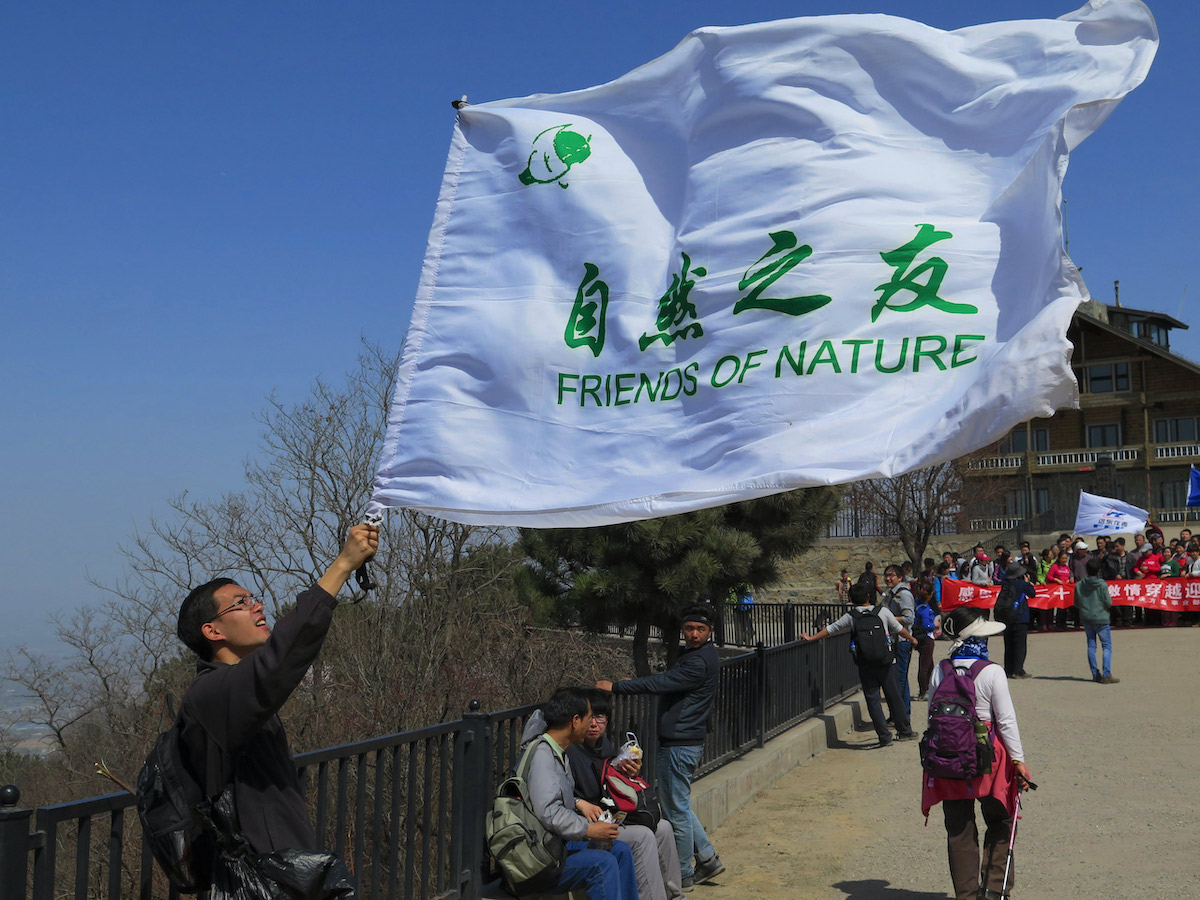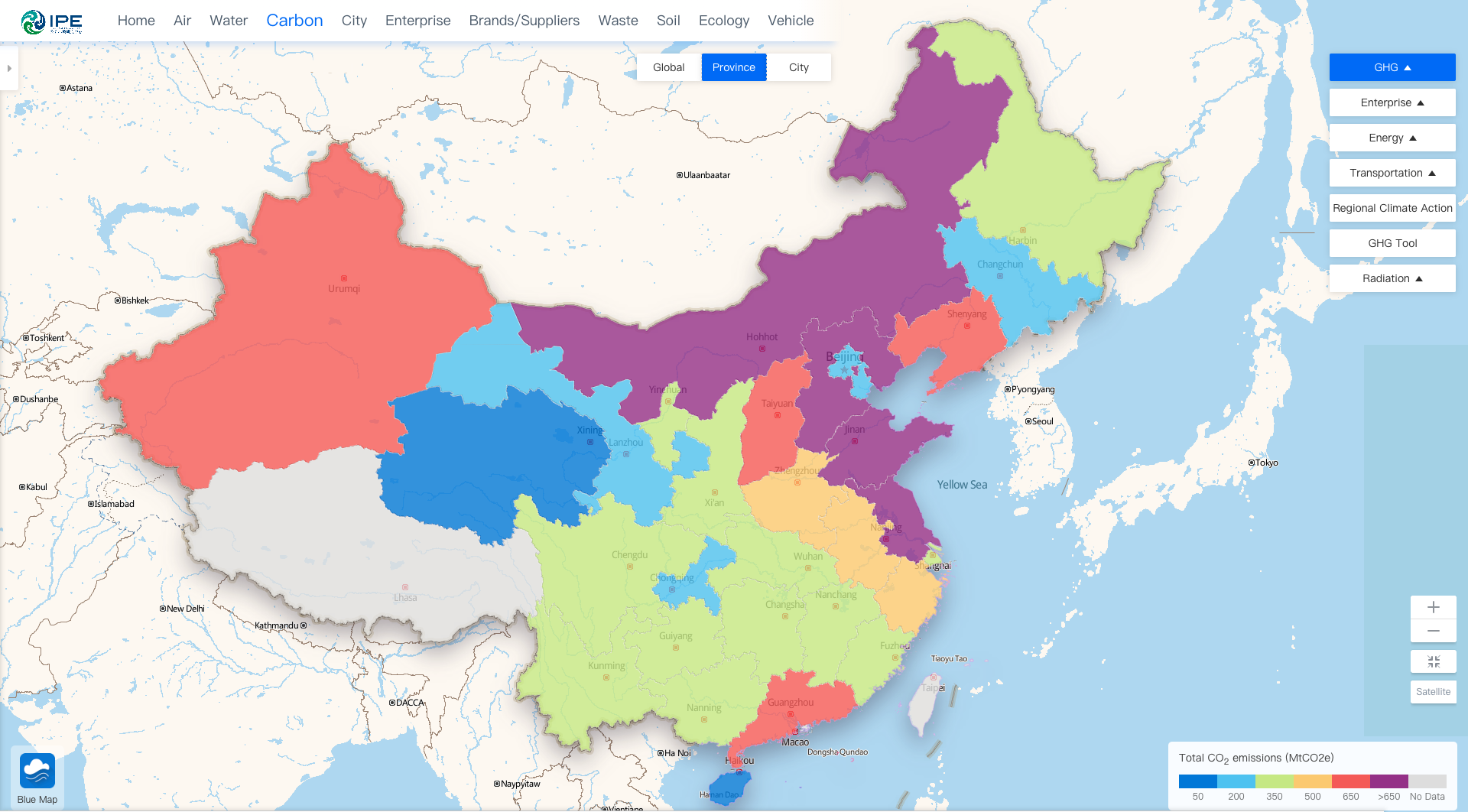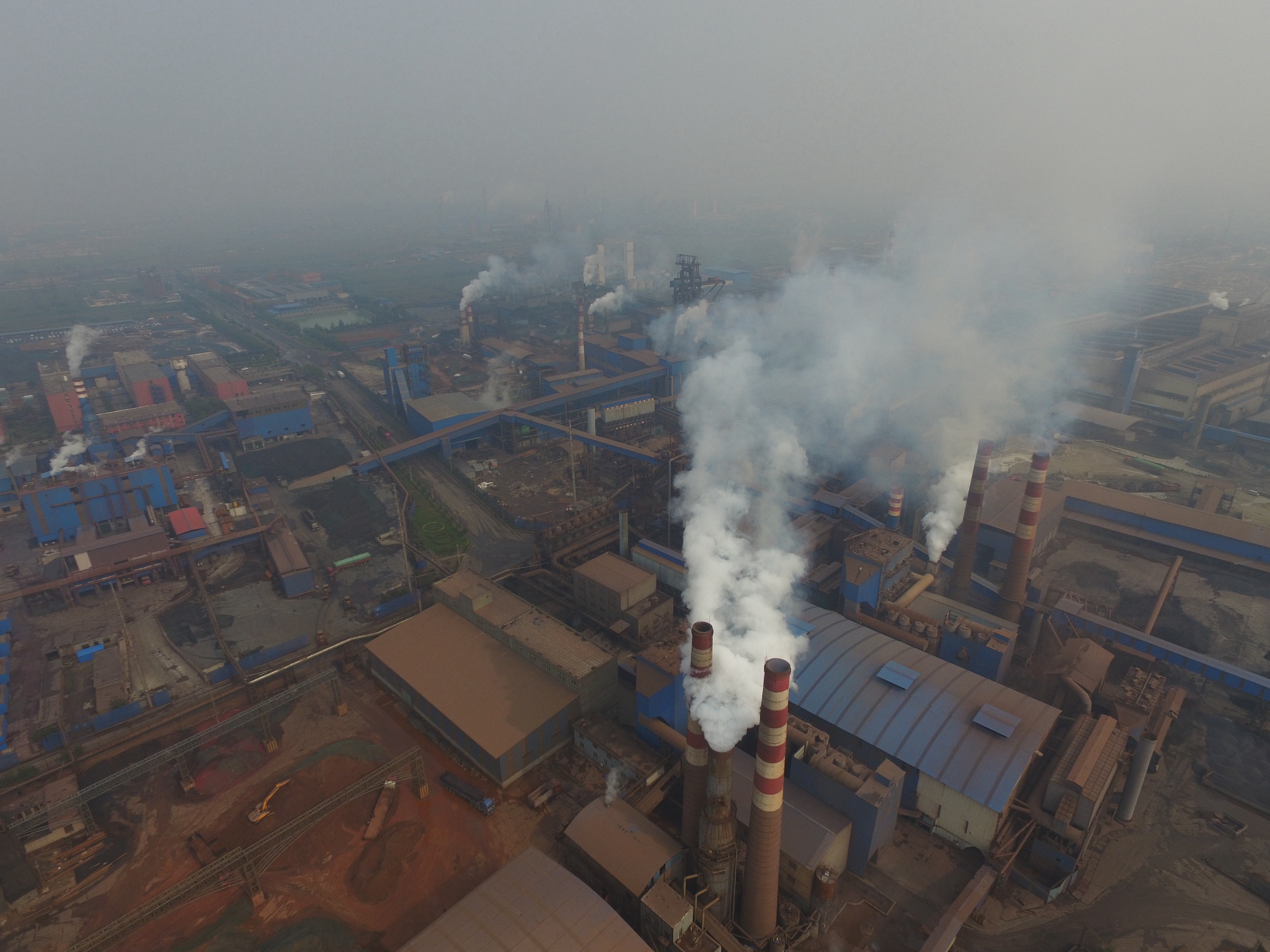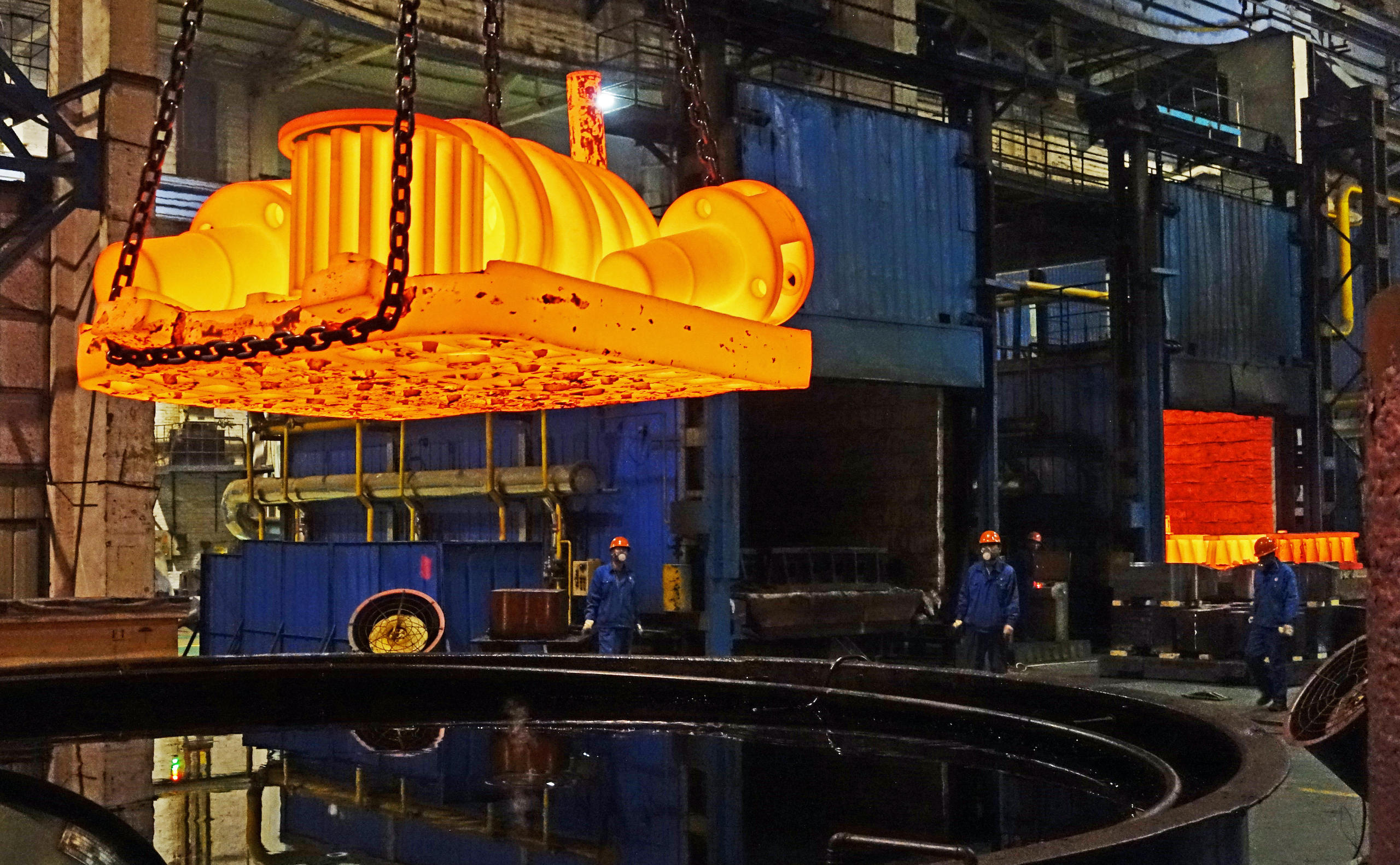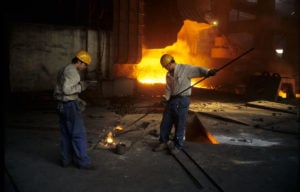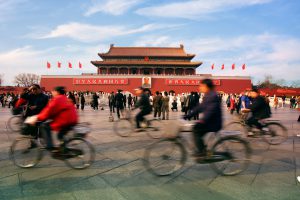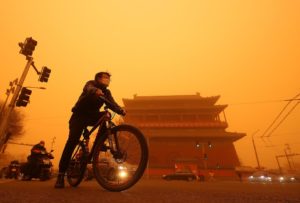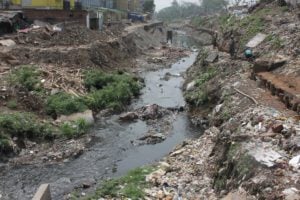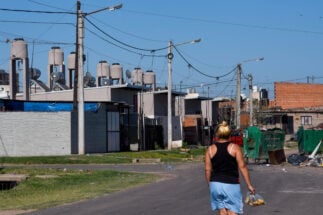The Institute of Public and Environmental Affairs (IPE), an environmental NGO, has diverged from similar organisations recently. Some joke it is now a leading tech firm.
“It’s true that more of my colleagues are now coders,” admits IPE director Ma Jun. “You can’t collect and use big data on the climate and environment without a good tech team.”
Ma Jun showed China Dialogue the IPE’s Blue Map mobile app. On its Carbon page, China’s provinces and cities are coloured according to their greenhouse gas emissions, so users can see where these are highest.
As climate change has moved up China’s political agenda, leading environmental NGOs like the IPE have started to work on climate governance. Yet their experience is not always transferable to the challenge of reducing greenhouse gases. That requires new ways of working and a deeper involvement in the country’s corporate and economic transitions.
Exit smog, enter carbon
In the decade up to 2020, the core work of the IPE and many similar organisations was promoting better governance of air pollution.
A turning point was in the winter of 2011, when air quality monitoring equipment at the US embassy in Beijing showed PM2.5 concentration at a shockingly high 522 µg/m3, which it labelled as “hazardous”. Yet the official government status merely read “light pollution”. The public had questions, and a long debate over smog ensued.
Environmental groups in cities including Beijing, Shanghai, Wuhan and Guangzhou launched a campaign, “Let’s monitor air quality for the motherland”. They also called on the government to publish PM2.5 figures and include PM2.5 in air quality standards. People started purchasing their own air quality monitors.
Less than two months after the campaign was launched, the government issued revised air quality standards, adopting World Health Organization recommendations on PM2.5 concentrations. Around the country, environmental authorities took measures to implement the new policy, including setting up new monitoring points. The following year, the State Council issued an air pollution action plan, with specific targets for PM2.5.
During that period, the IPE’s pollution map app – a predecessor of their current Blue Map – allowed users to check air quality, river water quality and pollution sources across 338 cities. Members of the public could monitor emissions of air and water pollutants from factories in real time. They could upload their own pictures of polluted waterways, using the data and images to send in reports to local environmental authorities. The IPE’s app received a boost when it was featured in Under the Dome, a documentary produced by China Central Television host Chai Jing. The hugely popular film sparked a sudden rush of downloads that temporarily overwhelmed its host servers.
The combination of public pressure and strong policy meant that the 2013 air pollution targets were all met by the 2017 deadline. In 2018, China published another air pollution action plan, this time with a three-year horizon. By 2021, average PM2.5 pollution in Beijing was down to 33 µg/m3 – below, for the first time, the new national standard of 35 µg/m3, and 63.1% lower than in 2013. The national average, meanwhile, fell from 72 µg/m3 in 2013 to 30 µg/m3 in 2021. Minister of Ecology and Environment Huang Runqiu described that as a historic change: China had achieved faster improvements in air quality than any other country.
As the smog gradually cleared, so attention shifted. The effort to reduce the carbon intensity of China’s industrial structure and energy mix showed how China could use environmental issues to drive its energy transition and improve its international leadership. In late 2014, in a joint statement from China’s president Xi Jinping and US president Barack Obama, China said for the first time that it would achieve peak carbon in or around 2030. That commitment paved the way to the Paris Agreement adopted in 2015.
In September 2020, while speaking to the UN General Assembly, Xi went further: China would peak carbon by or before 2030, and strive to reach carbon neutrality by 2060. Experts describe the so-called “dual carbon targets” as guiding China towards systematic reform across the energy sector, the environment and the economy. Carbon neutrality has duly become a hot topic, leading to public debate, adoption by businesses, and a stream of policy releases.
An invisible foe
Climate change is a much less visible problem than smog, and the underlying issues of oversight and industrial structure are more technically demanding. The experience NGOs had gained in the campaign against smog was no longer enough.
“After the ‘Let’s Monitor Air Quality for the Motherland’ campaign, China set up a huge monitoring network, publishing data on PM2.5, ozone and other pollutants in real time. It also became the first country to publish corporate emissions data [of pollutants] online and at scale,” said Ma Jun. “Our Blue Map app also hopes to make corporate emissions data visible and use public oversight to drive enforcement of environmental rules.”
The app allows users to submit reports of corporate violations, using images of pollution they have taken and emissions data of pollutants, directly to local environmental authorities, prompting them to order companies to take measures to reduce or eliminate pollution.
Green Taihang is another grassroots environmental organisation that has pushed the government to improve its environmental governance by exposing pollution. It has four full-time employees and was regarded by Hebei’s steel firms as a troublemaker. In its early work, it often came into direct conflict with the companies during on-site investigations. Li Fei of Green Taihang once published images of dozens of furnace chimneys belching thick smoke.
“The outcomes from our early reporting and tip-offs weren’t satisfactory,” he said. “But with the government’s introduction of measures to promote an ultra-low emission transformation in the iron and steel sector, we exposed the air pollution problems caused by poor management of production processes. We got a more positive response from the provincial and city governments, as well as the firms themselves, which wrote to us to explain what they were doing and invited us to visit.”
As the skies over Chinese cities turned blue, attention shifted to decarbonisation – and environmental organisations had to find a new approach.
“If a company breaches limits on sulphur dioxide emissions, I can see it because there’s monitoring,” said Liu Jinhai, director general of Friends of Nature. “But there’s no online monitoring of carbon dioxide emissions yet, so you don’t know how much is being released. And that lack of visibility is a big challenge for NGOs working on decarbonisation.”
Friends of Nature was founded in 1993 and is one of China’s oldest and most influential environmental NGOs. In the past decade, the group has taken several polluting firms to court to force them to clean up their activities.
“In the past, what NGOs would do was end-of-pipe monitoring – checking that pollutants met environmental standards,” explained Liu. “But when it comes to climate change, that alone is inadequate; they need to look at the whole system.”
A new route
For the IPE, the challenge is gathering carbon emission data and then using it to promote climate governance. The Blue Map serves as a public database, with data collected from 5,000 different sources – mostly from platforms belonging to the environmental, water, work safety and meteorological authorities, as well as corporate disclosure platforms. The database currently tracks over 60 types of environmental and corporate data from 12 million firms.
The Paris Agreement and Glasgow Climate Pact are prompting firms to make public commitments on climate and the environment. According to the UN, 270 companies worldwide (with a total market capitalisation of $3.6 trillion) have signed up to the Business Ambition for 1.5C commitment. The IPE, meanwhile, has published a Business Climate Action Index, encouraging Chinese firms to calculate and disclose emissions data and set reduction targets.
Steel capacity information could be made public, but when we requested it, we were refused every timeLi Fei, Green Taihang
“If companies disclose data and set targets, the public can keep an eye on whether those targets are achieved, or how far there is to go. Our index also evaluates how firms are performing on climate action within their sector – whether they are far in the lead or lagging at the back.” said Ma Jun. “Those evaluations and ranking can be quite powerful. The indexes and rankings we’ve published before got attention from local governments and big firms. Our green supply chain index has promoted 20,000 suppliers to make changes or disclosures.”
In October last year, the IPE worked with environmental organisation Green Jiangnan to collect and analyse publicly available data on 30 of China’s listed steel makers, scoring and ranking them based on governance mechanisms, calculations and disclosures, carbon targets and climate action, and photographic surveys carried out by drone. Some listed firms have taken the initiative, disclosing environmental data and publishing plans for change.
But despite this limited progress, obtaining corporate carbon emissions data remains a struggle. Carbon disclosure systems are just getting started in China and most of the available data has been published voluntarily. Disclosures are only mandatory for firms trading on carbon markets, which are currently only available to power generators. This means data for many big carbon emitters is not available. And even the data for those firms on the carbon market is incomplete. According to a recent report from the IPE, 347 of the 2,162 firms participating in the carbon market’s first implementation period have not made the full disclosures.
Li Fei met resistance when requesting information on steel capacity in Hebei.
“That’s information that could be made public, but when we requested it we were refused every time. Hebei is China’s biggest steel-making province and the figures could affect local stability, so they don’t want to make it public.”
“This year has basically been one long process of being knocked back,” complains Liu Jinmei, referring to 2022. “We asked for disclosure of information on energy saving audits and energy consumption. Almost all the requests were refused on the basis of commercial sensitivity. But without the information, it’s hard to see what companies are doing.”
Modes of transition
It isn’t just the problem of getting hold of data. Working on climate issues requires NGOs to develop a whole new way of thinking.
“The dual carbon targets [for peaking emissions and reaching carbon neutrality] meant we had to stop looking at individual points and start considering complete systems, even as high as the sectoral level, to find answers. That’s a huge challenge for an NGO,” said Liu Jinmei.
For Li Fei, this meant a shift from keeping an eye only on a company’s emissions to supervising, and even assisting, its low-carbon transition. “In the past, you could expose a pollution issue and it would get solved. But that’s not the case with carbon. You need more skills to build consensus with government and businesses and get them to implement the policies. Just identifying the problem isn’t enough,” said Li Fei.
Hebei, where Li Fei is based, is China’s biggest steel-making province. The steel sector, meanwhile, is China’s second largest industrial carbon emitter, behind power generation. Li Fei found that despite various national and local policies to restrict steel output being put in place since 2012, capacity in Hebei has actually gone up.
“They cut 120 million tonnes of capacity, but the total still went up 80 million tonnes. It doesn’t make sense,” said Li Fei. “We started looking at where in the process things had gone wrong.”
Green Taihang collated data from the government on its steel capacity replacement policy. This requires new production capacity to replace less efficient blast and basic oxygen furnaces, allowing local governments to drive efficiency upgrades whilst capping or reducing total capacity. As they were local, they were able to visit company sites to figure out details of production and environmental governance. This enabled the group to produce a report on progress on steel output reduction in the city of Handan, which they presented to the Ministry of Industry and Information Technology, the National Development and Reform Commission, and the provincial government. Two firms were quick to respond positively, removing blast furnaces and explaining what they were doing to reduce capacity.
Li Fei has found that the dual carbon targets are making businesses and local governments willing to work to cut carbon and pollution, but they need outside help to overcome difficulties. “We’re going to keep telling them what we observe and keep them current on low-carbon transition practices and the latest policy in their sector. That provides a basis for promoting consensus and action,” Li says.
Friends of Nature, meanwhile, found that taking companies to court over carbon emissions is especially challenging. Their case against the Ningxia subsidiary of the State Grid, for failing to take on solar and wind power generation, has been dragging on for six years. China’s Renewable Energy Law requires grid companies to buy in all renewable energy generated within their territory. But in 2015 and the first half of 2016, the company allowed 336 million kilowatt hours of wind and solar power to go to waste.
Traditional pollution cases are relatively simple: the offender can be ordered to stop polluting and pay compensation. The wastage of wind and solar power, however, involves a long and complex chain from generation, transmission, distribution, supply and usage of power. This makes it hard to use lawsuits to force the grid companies to take on more renewables. “In China, environmental public interest lawsuits still start with the concept of a tort – there needs to be harm or a significant risk of harm. That doesn’t work for climate cases,” explained Liu Jinmei.
Headwinds
Effective involvement by NGOs in decarbonisation will require ongoing attention to the process by both government and the public.
“Currently, we’re seeing global energy shortages, market turmoil and geopolitical tensions. All the major economies, including China, are focusing on security: energy security, food security and supply chain security. That led to the rebound in emissions we saw in 2021 and the headwinds we’re seeing on climate progress,” said Ma Jun.
Global market instability and the Covid-19 pandemic have slowed China’s economic growth. It is unclear if the decarbonisation trends that have allowed for NGO participation will continue. Jin Jun, an associate professor at Tsinghua University’s School of Social Sciences, studies the sociology of the environment and transitions, and has watched the development of China’s environmental NGOs closely.
Environmental organisations need to explain how important their work is for national targetsJin Jun, an associate professor at Tsinghua University
“The first thing for environmental organisations working on climate change and other environmental topics to do is explain how important their work is for national targets,” he says.
He thinks that legitimacy is the key challenge for those groups although it has eased in recent years as government concern with environmental protection has increased and as society has become more aware of decarbonisation targets. But if those economic and geopolitical headwinds prompt the government to prioritise economic stability and energy security, those environmental organisations may face more resistance.
Despite a global lack of focus on climate governance, the IPE’s Ma Jun thinks the dual carbon targets still give environmental organisations an opportunity to get involved and drive changes in China’s energy mix and industrial structure.
“Decarbonisation will take almost 40 years. It will require more input from government, businesses and the public,” said Ma Jun, adding: “Our hope for the future is that environmental NGOs will use the experience gained in the fight against air pollution, and the synergies between reducing carbon and reducing pollution, to further improve air quality and realise green and low-carbon development.”
